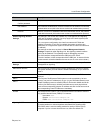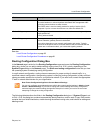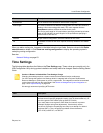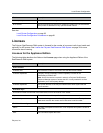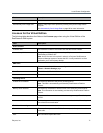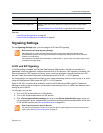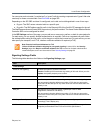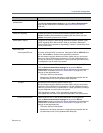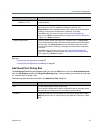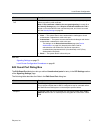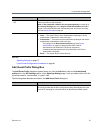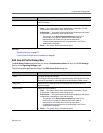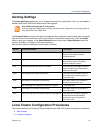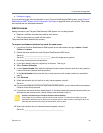
Local Cluster Configuration
Polycom, Inc. 75
Enable H.323 device
authentication
Check the box to turn on H.323 device authentication.
Click Device authentication settings to go to the Device Authentication
page and add authentication credentials (see Device Authentication on
page 261).
SIP Settings
Enable SIP signaling Enables the system to receive Session Initiation Protocol (SIP) calls.
Caution: Disabling SIP terminates any existing SIP calls. When you click
Update, the system prompts you to confirm.
Enable ANAT support Configures the system to pass through Alternative Network Address Types
(ANAT) signaling (RFC 4091 and RFC 4092) in the Session Description
Protocol (SDP) for the purpose of negotiating IP version in a dual-stack (IPv4
+ IPv6) environment.
Authorized ports
Unencrypted SIP port To permit unencrypted SIP connections, select either TCP or UDP/TCP from
the list. Select None to disallow unencrypted SIP connections.
We recommend using the default port number (5060), but you can use any
value from 1024 to 65535 that’s not already in use and is different from the
TLS port and from any “unauthorized” or “guest” ports that your SBC(s) may
be configured to use for calls to the system.
Enable authentication Check the box to turn on SIP device authentication for unencrypted SIP.
Click the Device authentication settings link to go to the Device
Authentication page to configure SIP device authentication and add device
authentication credentials (see Device Authentication on page 261). The
settings on that page determine:
• The realm used for authentication.
• Whether the Call Server responds to unauthenticated requests with 401
(Unauthorized) or 407 (Proxy Authentication Required).
TLS port Specifies the port number the system uses for TLS.
We recommend using the default port number (5061), but you can use any
value from 1024 to 65535 that’s not already in use and is different from the
UDP/TCP port and from any “unauthorized” or “guest” ports that your SBC(s)
may be configured to use for calls to the system.
If SIP signaling is enabled, TLS is automatically supported. Unless
unencrypted SIP connections are specifically permitted, TLS must be used.
Enable authentication Check the box to turn on SIP device authentication for encrypted SIP.
Click the Device authentication settings link to go to the Device
Authentication page to configure SIP device authentication and add device
authentication credentials (see Device Authentication on page 261). The
settings on that page determine:
• The realm used for authentication.
• Whether the Call Server responds to unauthenticated requests with 401
(Unauthorized) or 407 (Proxy Authentication Required).
Field Description



